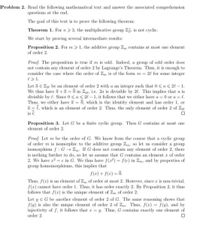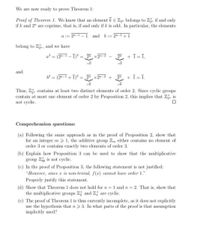
Advanced Engineering Mathematics
10th Edition
ISBN: 9780470458365
Author: Erwin Kreyszig
Publisher: Wiley, John & Sons, Incorporated
expand_more
expand_more
format_list_bulleted
Question
please send solution for part b
only handwritten solution accepted

Transcribed Image Text:Problem 2. Read the following mathematical text and answer the associated comprehension
questions at the end.
The goal of this text is to prove the following theorem:
Theorem 1. Forn> 3, the multiplicative group Z. is not cyclic.
We start by proving several intermediate results:
Proposition 2. For m 1, the additive group Z contains at most one element
of order 2.
Proof. The proposition is true if m is odd. Indeed, a group of odd order does
not contain any element of order 2 by Lagrange's Theorem. Thus, it is enough to
consider the case where the order of Zm is of the form m = 20 for some integer
e>1.
Let ā e Zu be an element of order 2 with a an integer such that 0 < a < 2l – 1.
We thus have a +ā = 0 in Z2e, i.e. 2a is divisible by 20. This implies that a is
divisible by l. Since 0 < a < 2l-1, it follows that we either have a 0 or a = l.
Thus, we either have a =
0, which is the identity element and has order 1, or
a = 1, which is an element of order 2. Thus, the only element of order 2 of Zu
is 7.
Proposition 3. Let G be a finite cyclic group. Then G contains at most one
element of order 2.
Proof. Let m be the order of G. We know from the course that a cyclic group
of order m is isomorphic to the additive group Zm, so let us consider a group
isomorphism f : G → Zm. If G does not contain any element of order 2, there
is nothing further to do, so let us assume that G contains an element r of order
2. We have a2 = e in G. We thus have f(a2) = f(e) in Zm, and by properties of
group homomorphisms, this implies that
f(r) + f(x) = 0.
%3D
Thus, f(x) is an element of Z, of order at most 2. However, since r is non-trivial,
f(r) cannot have order 1. Thus, it has order exactly 2. By Proposition 2, it thus
follows that f(x) is the unique element of Zm of order 2.
Let y E G be another element of order 2 of G. The same reasoning shows that
f(y) is also the unique element of order 2 of Zm. Thus, f(r) = f(y), and by
injectivity of f, it follows that r = y. Thus, G contains exactly one element of
order 2.

Transcribed Image Text:We are now ready to prove Theorem 1:
Proof of Theorem 1. We know that an element k E Zyn belongs to Z, if and only
if k and 2" are coprime, that is, if and only ifk is odd. In particular, the elements
a := 2"-1 -1 and b:= 2n-1 +1
belong to Z, and we have
a² = (2"-I - T)² :
2n x2n-2
+ T = T,
%3D
2n
and
(2"-1+1)2:
2" x2n-2
+ ī =T.
2n
Thus, Z contains at least two distinct elements of order 2. Since cyclic groups
contain at most one element of order 2 by Proposition 2, this implies that Z is
not cyclic.
Comprehension questions:
(a) Following the same approach as in the proof of Proposition 2, show that
for an integer m > 1, the additive group Zm either contains no element of
order 3 or contains exactly two elements of order 3.
(b) Explain how Proposition 3 can be used to show that the multiplicative
group Z is not cyclic.
(c) In the proof of Proposition 3, the following statement is not justified:
"However, since a is non-trivial, f(x) cannot have order 1."
Properly justify this statement.
(d) Show that Theorem 1 does not hold for = 1 and n 2. That is, show that
the multiplicative groups Z and Z are cyclic.
(e) The proof of Theorem 1 is thus currently incomplete, as it does not explicitly
use the hypothesis that n > 3. In what parts of the proof is that assumption
implicitly used?
Expert Solution
This question has been solved!
Explore an expertly crafted, step-by-step solution for a thorough understanding of key concepts.
Step by stepSolved in 5 steps

Knowledge Booster
Similar questions
- Please check if there is more than one solution so I can see how to do it.arrow_forwardcan you further elaborate with complete solutionarrow_forwardIt takes Doug 3 days to reroof a house. If Doug's son helps him, the job can be completed in 2 days. How long would it take Doug's son, working alone, to do the job?arrow_forward
- twenty two more than four times a number is equal to the dofference between 155 ans three times the number. whats the numberarrow_forwardPlease do not give solution in image format thankuarrow_forwardSeven times a two digit number is equal to four times the number obtained by reversing the digits .if the difference between the digits is 3 .Find the numberarrow_forward
arrow_back_ios
arrow_forward_ios
Recommended textbooks for you
 Advanced Engineering MathematicsAdvanced MathISBN:9780470458365Author:Erwin KreyszigPublisher:Wiley, John & Sons, Incorporated
Advanced Engineering MathematicsAdvanced MathISBN:9780470458365Author:Erwin KreyszigPublisher:Wiley, John & Sons, Incorporated Numerical Methods for EngineersAdvanced MathISBN:9780073397924Author:Steven C. Chapra Dr., Raymond P. CanalePublisher:McGraw-Hill Education
Numerical Methods for EngineersAdvanced MathISBN:9780073397924Author:Steven C. Chapra Dr., Raymond P. CanalePublisher:McGraw-Hill Education Introductory Mathematics for Engineering Applicat...Advanced MathISBN:9781118141809Author:Nathan KlingbeilPublisher:WILEY
Introductory Mathematics for Engineering Applicat...Advanced MathISBN:9781118141809Author:Nathan KlingbeilPublisher:WILEY Mathematics For Machine TechnologyAdvanced MathISBN:9781337798310Author:Peterson, John.Publisher:Cengage Learning,
Mathematics For Machine TechnologyAdvanced MathISBN:9781337798310Author:Peterson, John.Publisher:Cengage Learning,


Advanced Engineering Mathematics
Advanced Math
ISBN:9780470458365
Author:Erwin Kreyszig
Publisher:Wiley, John & Sons, Incorporated

Numerical Methods for Engineers
Advanced Math
ISBN:9780073397924
Author:Steven C. Chapra Dr., Raymond P. Canale
Publisher:McGraw-Hill Education

Introductory Mathematics for Engineering Applicat...
Advanced Math
ISBN:9781118141809
Author:Nathan Klingbeil
Publisher:WILEY

Mathematics For Machine Technology
Advanced Math
ISBN:9781337798310
Author:Peterson, John.
Publisher:Cengage Learning,

